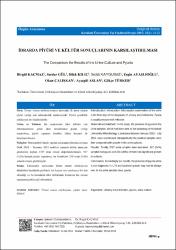| dc.contributor.author | Kaçmaz, Birgül | |
| dc.contributor.author | Gül, Serdar | |
| dc.contributor.author | Kılıç, Dilek | |
| dc.contributor.author | Kaygusuz, Sedat | |
| dc.contributor.author | Ayaşlıoğlu, Ergin | |
| dc.contributor.author | Çalışkan, Okan | |
| dc.contributor.author | Aslan, Ayşegül | |
| dc.date.accessioned | 2021-01-14T18:19:39Z | |
| dc.date.available | 2021-01-14T18:19:39Z | |
| dc.date.issued | 2016 | |
| dc.identifier.citation | KAÇMAZ B,GÜL S,KILIÇ D,KAYGUSUZ S,AYAŞLIOĞLU E,ÇALIŞKAN O,ASLAN A,TÜRKER G (2016). İDRARDA PİYÜRİ VE KÜLTÜR SONUÇLARININ KARŞILAŞTIRILMASI. Kırıkkale Üniversitesi Tıp Fakültesi Dergisi, 18(1), 19 - 22. | en_US |
| dc.identifier.issn | 2148-9645 | |
| dc.identifier.issn | 2148-9645 | |
| dc.identifier.uri | https://app.trdizin.gov.tr/makale/TWpFMk56azNOdz09 | |
| dc.identifier.uri | https://hdl.handle.net/20.500.12587/13782 | |
| dc.description.abstract | Giriş: Üriner sistem enfeksiyonunun tanısında ilk adım idrarın piyüri varlığı için mikroskobik incelemesidir. Piyüri genellikle enfeksiyon ile ilişkilendirilir. Gereç ve Yöntem: Bu araştırmada idrar kültürü için laboratuarımıza gelen idrar örneklerinde piyüri varlığı araştırılmış, piyüri saptanan örnekler kültür üremesi ile karşılaştırılmıştır. Bulgular: Retrospektif olarak yapılan çalışmada laboratuvarımıza Ocak 2015 - Temmuz 2015 tarihleri arasında kültür amacıyla gönderilen toplam 3787 idrar örneği değerlendirilmiştir. 927 (%24) hastada piyüri saptanmış, bu örneklerin 336'sında (%36) anlamlı üreme görülmüştür. Sonuç: Çalışmanın sonucunda üriner sistem enfeksiyonu düşünülen hastalarda piyürinin tek başına tanı koydurucu bir test olmadığı ve bu hastalarda idrar kültüründe üremenin her zaman saptanamayabileceği bilinmelidir. | en_US |
| dc.description.abstract | Introduction: Introduction: Microscobic examination of the urine is the first step of the diagnosis of urinary tract infections. Pyuria is usually related with infection. Material and Method: In this study, the presence of pyuria in the urine samples, which had been sent to the laboratory of Kirikkale University Microbiology Laboratory between January 2015 - July 2015, were examinated retrospectively the positive samples were then compared with growth in the urine cultures. Results: Totally 3787 urine samples were examined. 927 (24%) samples had pyuria and 336 (36%) of them had significant growth in cultures. Conclusion: Accordingly our results, the presence of pyuria alone is not diagnostic in UTI and bacterial growth may not be always seen in the urine samples have pyuria. | en_US |
| dc.language.iso | tur | en_US |
| dc.rights | info:eu-repo/semantics/openAccess | en_US |
| dc.subject | Genel ve Dahili Tıp | en_US |
| dc.title | İDRARDA PİYÜRİ VE KÜLTÜR SONUÇLARININ KARŞILAŞTIRILMASI | en_US |
| dc.title.alternative | The Comparison the Results of the Urine Culture and Pyuria | en_US |
| dc.type | article | en_US |
| dc.identifier.volume | 18 | en_US |
| dc.identifier.issue | 1 | en_US |
| dc.identifier.startpage | 19 | en_US |
| dc.identifier.endpage | 22 | en_US |
| dc.relation.journal | Kırıkkale Üniversitesi Tıp Fakültesi Dergisi | en_US |
| dc.relation.publicationcategory | Makale - Ulusal Hakemli Dergi - Kurum Öğretim Elemanı | en_US |
















